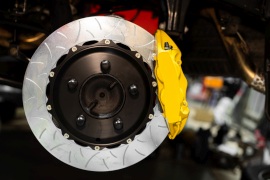Ceramic brake discs ideally last the life of a car. Their manufacture, and in particular the production of the friction layer for the brake discs, requires special know-how and consistent quality assurance. One part of this is testing with active thermography. The main aim here is to ensure that the friction layer is securely bonded to the supporting body.
The application:
Ceramic brake discs are often easy to recognize on a vehicle by the yellow-painted brake calipers. In the case of new developments, it is not quite so easy for a manufacturer to see whether the friction layer on the supporting body will really hold up under all conditions. For this purpose, in addition to durability tests, lockin thermography tests are also undertaken, among other things. To ensure that the joint will hold, it is particularly important to check the material properties beneath the surface. Lockin thermography is a well-suited test method for this purpose. It would also be possible to analyze the interface using X-ray methods, but this test would be much more complex and would take significantly longer.
The task:
The friction layer is a ceramic material that is bonded to the supporting body. The connection between the two partners is essential for the braking effect. Delaminations should be reliably detected in order to avoid them in the manufacturing process. edevis was to help diagnose these processes with thermographic methods.
The solution:
After production, the condition and quality of the brake discs is documented with zero measurements and a so-called service life file is created. After that, the brake discs are loaded in endurance test rigs and repeatedly examined on thermographic test rigs at specific intervals. This process ends when the desired number of cycles is reached (or the test specimen fails). The brake discs produced can vary in diameter and thickness depending on the type. The test process is adjusted to this and tests the coatings of the discs on both sides. The results are documented in the test report, evaluated by the development department and fed back into the manufacturing process.
The challenge:
The particular challenge that the manufacturer posed to edevis also met a strength of the thermographic test method: delamination processes were to be identified at an early stage, before the friction layers fail. Although the interface of such a delamination is only a few micrometers thick, it can be easily located thermographically. The emergence and developments of delamination can thus be tracked and documented until the damage occurs.
The project planning:
The initial task of edevis was to perform contract testing for the customer. In the further progress of the project, an easy-to-operate test stand was developed, which is in use at the customer’s site and enables non-destructive and reproducible spot checks and validation tests.
